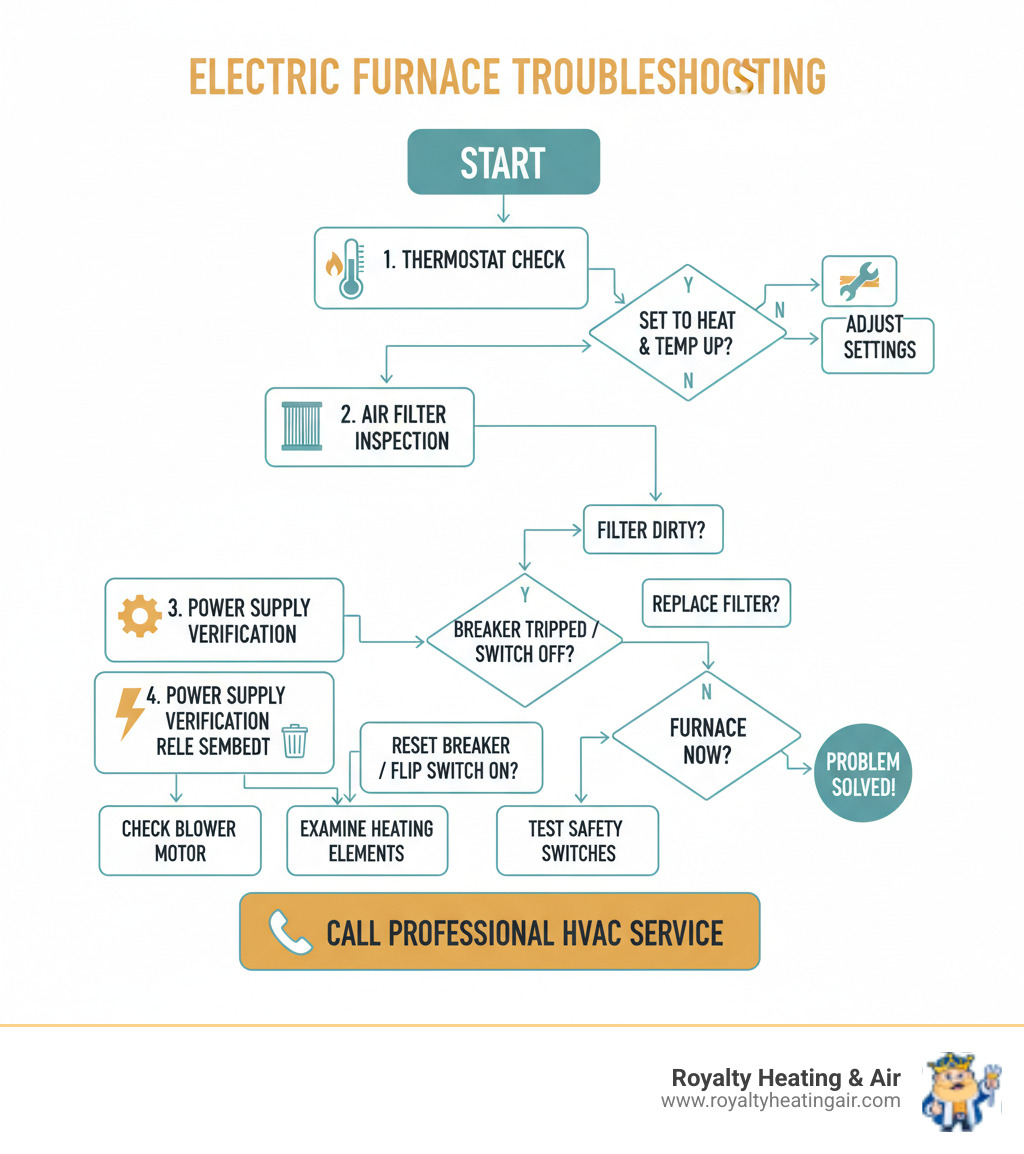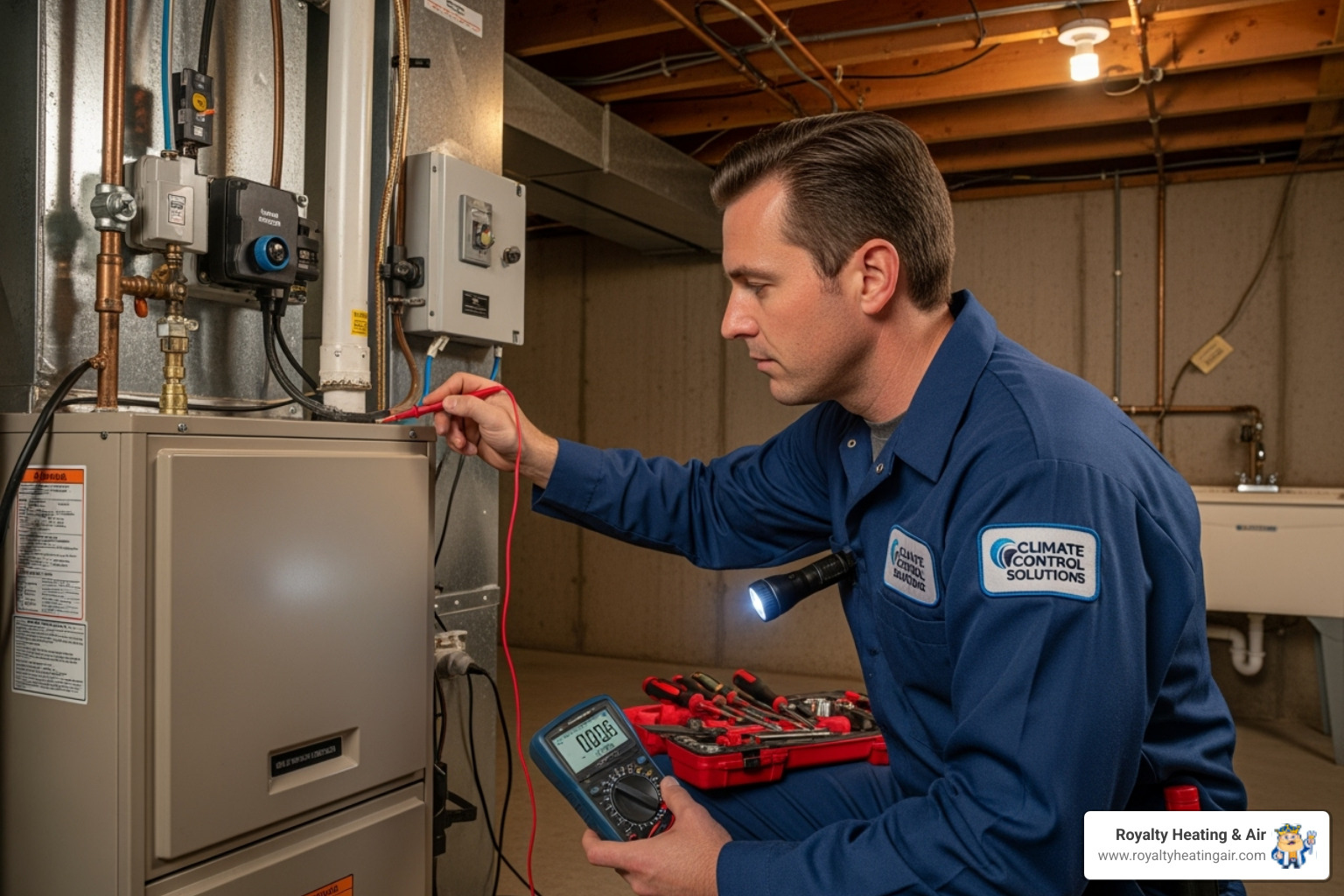Electric furnace troubleshooting begins with understanding the common causes of heating failures. When your furnace stops working in cold weather, it feels like an emergency, but many issues have simple solutions you can handle yourself. Often, the problem is as basic as a wrong setting, a tripped breaker, or a dirty filter.
When an electric furnace fails in freezing weather, your home's temperature can drop quickly, creating discomfort and stress. This guide provides systematic troubleshooting steps, from easy DIY fixes to recognizing when to call a professional, helping you diagnose issues safely and restore your heat.
Quick Troubleshooting Checklist:

Before calling for help when your electric furnace stops working, walk through these simple fixes. Many electric furnace troubleshooting situations stem from basic oversights any homeowner can handle, potentially saving you time and money.

Your thermostat is the command center for your heating system and a common source of problems. First, check the settings. Ensure it's set to "HEAT" mode and the temperature is at least 3-5 degrees higher than the current room temperature. A surprising number of service calls are resolved with this simple adjustment.
If your thermostat screen is dim or blank, try replacing the batteries. Also, check the blower fan setting. If the fan runs constantly but doesn't produce heat, the fan may be set to "ON" instead of "AUTO." The "ON" setting circulates air continuously, while "AUTO" runs the fan only during heating cycles.
Thermostat placement also matters. If it's near a draft, in direct sunlight, or close to a heat source, it can get inaccurate temperature readings, causing erratic heating. If you're getting cold air from your vents, our guide on Furnace Blowing Cold Air: Causes and Fixes offers more detail.
A dirty air filter is one of the most common causes of furnace problems. A clogged filter restricts airflow, forcing your furnace to work harder, which can lead to overheating and a system shutdown. This not only reduces efficiency and increases energy bills but also puts unnecessary strain on components.
To check your filter, pull it out and inspect it. If it's gray, covered in a thick layer of debris, or you can't see light through it, it needs to be replaced. As Home Depot notes, simply cleaning or replacing a clogged filter often solves the problem.
To replace it, turn off the furnace at the thermostat and the main power switch. Locate the filter slot, slide out the old one, and note its size and the airflow direction arrow. Insert the new filter with the arrow pointing toward the furnace, then restore power. Most filters should be changed every 90 days, but check monthly if you have pets, allergies, or during heavy winter use.
Electric furnaces are entirely dependent on electricity. When that power is interrupted, your heating system will fail. Understanding these electric furnace troubleshooting power issues can help you restore heat quickly.

If your furnace suddenly stops, an electrical issue is a likely cause. First, find your electrical panel, usually in a garage, basement, or utility room. Look for a tripped breaker—a switch that is in a middle position or flipped to "OFF." To reset it, push the switch firmly to "OFF," then back to "ON." If the breaker trips again immediately, it signals a more serious electrical problem that requires a professional.
Your furnace also has internal fuses on its control board that protect components from power surges. Before checking them, always turn off power to the furnace at the main electrical panel. A blown fuse may look discolored or have a broken filament. Replace it with a new fuse of the exact same size, type, and amperage to avoid fire hazards. Sometimes, even a dirty fuse can cause a poor connection, so a visual inspection is worthwhile.
Repeatedly tripped breakers or blown fuses indicate an underlying issue that needs professional diagnosis. For more on home electrical systems, see this resource on electrical systems.
Beyond the main power supply, complex wiring and control systems can develop problems. A common issue is the front panel door safety switch; if the access panel isn't fully closed, the furnace won't run. Ensure all panels are secure.
Normal furnace operation can cause vibrations that loosen electrical connections over time, leading to intermittent power or system failure. If you see burnt or melted wires or smell burning plastic, shut off power immediately and call a professional, as this is a fire hazard.
Problems with the thin thermostat control wire can also prevent the furnace from receiving heating commands. If this wire fails, the blower might run, but the unit won't heat. Water contact near any electrical components is also dangerous and requires immediate power shut-off and professional repair. For complex issues like a faulty starting capacitor, transformer, or control panel, professional service is necessary for a safe and proper repair. Our guide on Heater Not Working: The Ultimate Guide covers more advanced troubleshooting.
If basic checks don't solve the problem, the issue likely lies with a specific component inside your furnace. Understanding the symptoms of a failing part can help you identify the problem.
The blower motor pushes warm air through your ducts. When it fails, you'll notice clear signs. The most obvious is no airflow from your vents, even if the furnace sounds like it's running. Weak airflow can also indicate a struggling motor or significant ductwork leaks.
Listen for unusual sounds like squealing, grinding, or rattling, which often point to worn-out motor bearings that need replacement. A failing blower motor can also cause the furnace to overheat, triggering a safety shutdown to prevent damage. Because the heating elements are working but the air isn't circulating, you won't feel any warmth.
Replacing a blower motor requires specialized knowledge and is not a typical DIY project. Our guide on Furnace Blower Motor Issues and Solutions provides more insight.
These electrical components coordinate the heating process, and their failure can cause puzzling symptoms, making electric furnace troubleshooting more complex.
Diagnosing these failures is difficult without specialized tools like a multimeter, as symptoms can overlap. For instance, a fan that won't start could be due to a bad relay, control board, motor, or transformer. Due to the electrical risks, it's best to call a professional for these issues. Our guide on Furnace Not Igniting: Troubleshooting Steps covers related problems.
While DIY troubleshooting is useful, some problems are beyond the scope of safe homeowner repairs and require professional expertise. Knowing when to stop and call for help is a critical part of electric furnace troubleshooting.

If you notice any of the following signs, immediately shut off power to your furnace at the thermostat and the main electrical panel, then contact a certified HVAC technician.
For more on identifying these situations, see our guide on When to Call Us for Heater Repair.
Minor issues, like a dirty filter or incorrect thermostat settings, are ideal for DIY fixes. Major issues involve complex electrical or mechanical components and require a professional. These include a faulty blower motor, a circuit breaker that won't stay reset, or repeatedly blowing internal fuses.
Problems with starting capacitors, transformers, or sequencers also fall into the major issue category and are best left to trained technicians. Consider replacement if your furnace is over 15-20 years old and requires frequent or costly repairs. A major repair costing more than half the price of a new unit is often not economical. A new, efficient model can also lower energy bills, paying for itself over time. If you're facing this decision, we can help you explore Residential Heater Installation Services.
The best way to handle electric furnace troubleshooting is to prevent problems from occurring. Regular maintenance extends your unit's life, improves efficiency, and ensures reliable heating.
Consistent, simple tasks can prevent major headaches. Here's a basic maintenance checklist for homeowners:
Our guide on Preventative Heater Maintenance Tips for Homeowners offers more detailed advice.
While DIY maintenance is valuable, an annual professional tune-up is essential for catching problems early. A technician will perform a comprehensive inspection that homeowners can't.
During a tune-up, a professional will:
An annual tune-up ensures your furnace operates safely and efficiently when you need it most. Learn more in our article on Annual Furnace Inspection: Why It's Crucial.
Here are answers to common questions we hear from homeowners in the Roseville area about their heating systems.
The three most frequent culprits in electric furnace troubleshooting are a tripped circuit breaker, a clogged air filter, or incorrect thermostat settings. These account for a majority of service calls and are all issues you can check yourself before calling a professional.
This is often caused by the thermostat's fan setting. If the fan is set to "ON" instead of "AUTO," the blower will run constantly to circulate air, even when the furnace isn't heating. Switch the setting to "AUTO." If that doesn't work, the problem could be a stuck relay or a wiring issue that requires professional attention.
If you hear the furnace running but feel little warmth, the most likely cause is a severely clogged air filter restricting airflow. If you've already replaced the filter, other potential causes include failed heating elements, a malfunctioning blower motor, or leaky ductwork that is losing heated air before it reaches your rooms. These issues typically require professional diagnosis.
When your electric furnace troubleshooting efforts don't resolve the issue, it's time to bring in the professionals. Complex electrical problems, such as a faulty transformer or damaged control board, and persistent component failures are not DIY tasks and require the specialized tools and knowledge of a certified HVAC technician.
If you've worked through our checklist and your home is still cold, don't hesitate to call for help. A professional can quickly and safely diagnose issues that are difficult for homeowners to identify.
At Royalty Heating & Air, we understand the stress of a failed heating system, especially during the chilly winter nights in Northern California communities like Roseville, Rocklin, and Granite Bay. Your family's comfort and safety are our top priorities.
What makes us different is our commitment to our community. Through our partnership with the MackAttack Foundation, every service call helps support foster babies and sponsor family adoptions in our area. When you choose us, you're not just getting expert service—you're helping make a difference in a child's life.
Whether you're dealing with a furnace that won't start or other safety concerns, our experienced technicians are ready to restore warmth to your home. For reliable and expert heating repair in Roseville, CA, contact us today.
